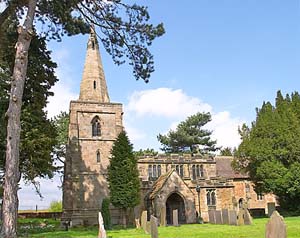Denby village is situated 8 miles north of Derby and was mentioned in Domesday as Denebi, which means village of the Danes. Rykneld Street which is the old Roman road, runs on the western part of the parish for 2,440 yards in a straight line from Bottle Brook to the northern boundary of Street Lane.
In 1831 Denby contained 240 houses most of which were thatched, 243 families and 1272 inhabitants. Of the families 50 were chiefly employed in agriculture, 30 in trade and handicraft and the other 163 were directly employed in working the extensive collieries and ironstone pits. Most of the land and collieries belonged to the Drury-Lowe family of Locko Park, Spondon, Derby. They have been patrons of the village church for well over 400 years.

Denby church |
The area was very rich in coal, but clay also played a large part in the village's development. In 1806 a turnpike was constructed from Denby to Alfreton and as it passed through Denby, a bed of clay was uncovered. This was found to be the finest stoneware clay in Europe, hence in 1809 Denby Pottery began production of its now world famous stoneware.
In it's early days the pottery was in run by Joseph Bourne. Stoneware pots and bottles were the order of the day for everything from beer to ink, with Bourne proving himself to be not only an excellent potter but also an energetic and shrewd businessman. By 1832 Denby had become the biggest exporter of bottles and jars in the UK. Estimates put the workforce at Joseph Bourne's time as around 200. Potteries were labour intensive and the early days on the outside site would have been very hard. It was one man's job to go down a vertical shaft with a bucket and take out the clay with a pickaxe and shovel, in a process aptly described as 'wallow work'. The bucket was then winched up by a gin and the clay taken by horse and cart to the pottery, where each thrower was assisted by a woman or child who made the clay into a ball. Salt was thrown on the fire as the pots were fired in the kilns, and the resulting vapours combined with the surface of the pot to give it its characteristic shiny brown coating.
The Pottery is actually situated about a mile from the main village and provides employment for about 650 people from the locality. It also draws around 300,000 visitors a year to its factory and visitor's centre. Forty percent of the potteries output is exported, with Canada, Italy, Norway and Sweden the largest markets, after America, and though new ranges come in all the time, the dark blue and green tableware is the perennial favourite, its unique glaze instantly recognisable as Denby.
Breach Cottage was a meeting place for Quakers from 1678 to 1834 and is where the remains of 200 members of the society are buried.
Two famous men were born in Denby. Firstly John Flamstead, who became the first Astronomer Royal and who's name is taken by the local comprehensive school. Secondly Benjamin Outram, a railway engineer. He built, amongst others, the Outram railway line from Smithy House to Little Eaton for the purpose of carting coal by horse drawn trucks to the canal wharf at Little Eaton.
Tarmacadam was founded here by accident at the start of the 20th century and it revolutionized road building.
The church of the Virgin Mary has a 14th century tower and spire and a 17th century alter table. The rest was much restored in the 19th century. Sir Drury Drury-Lowe was buried here in 1908. He fought at Sebastopol, saw the closing scenes of the Indian Mutiny, and in the Egyptian War of 1882 made a daring moonlight cavalry charge which saved Cairo from destruction.
The Church celebrates the 8th of September with a flower festival and concert.